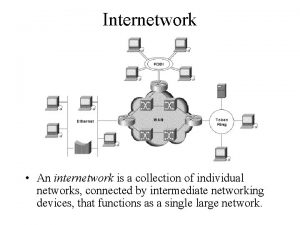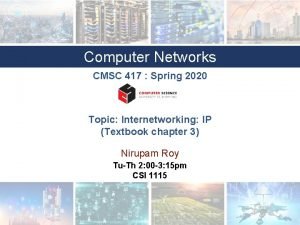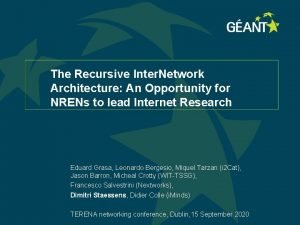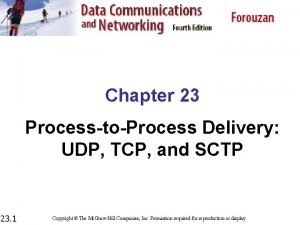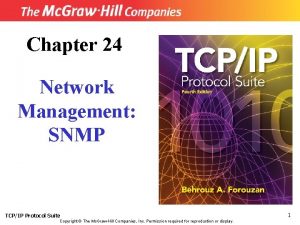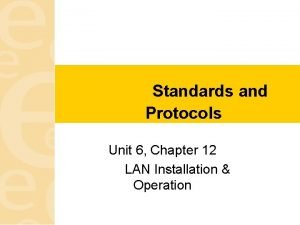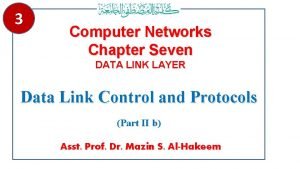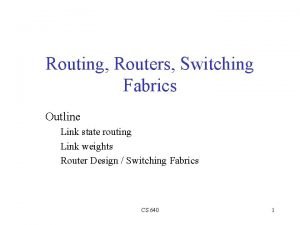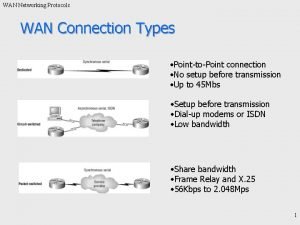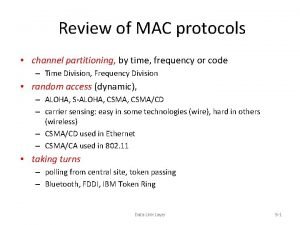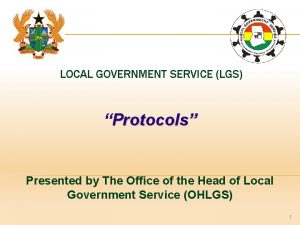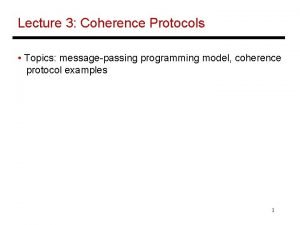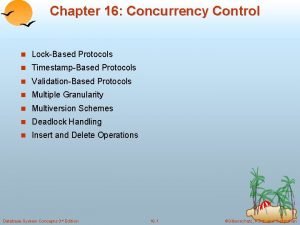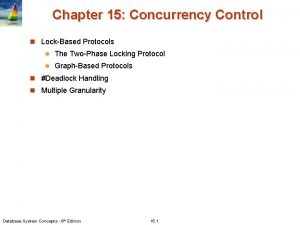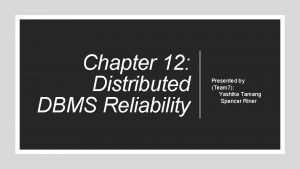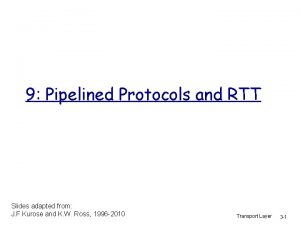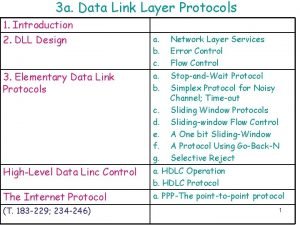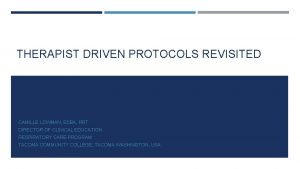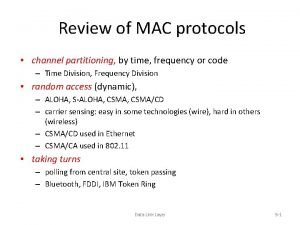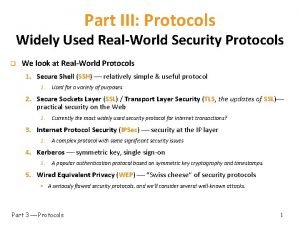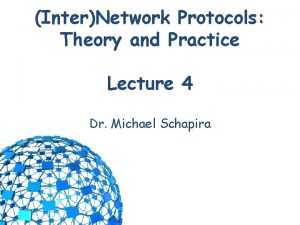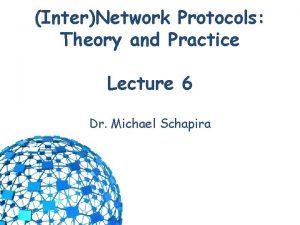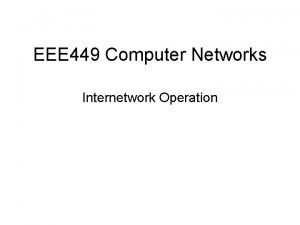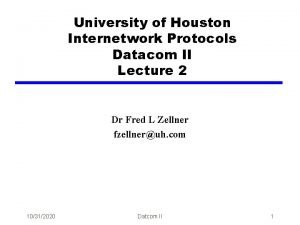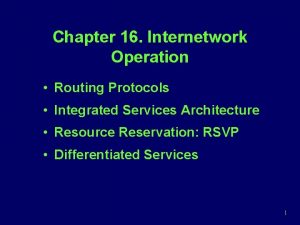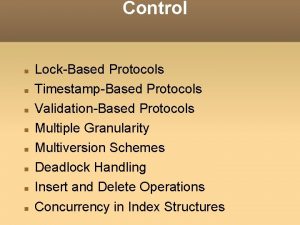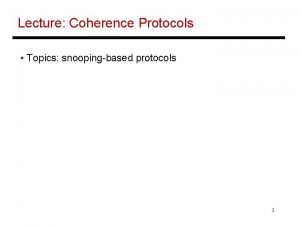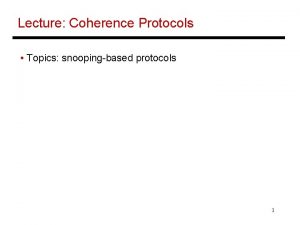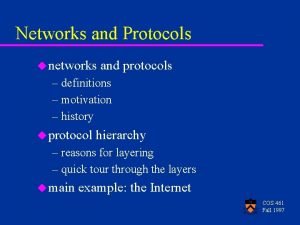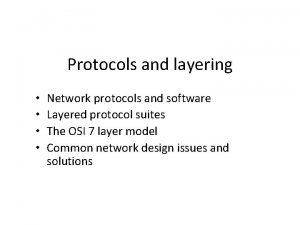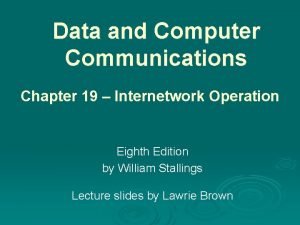InterNetwork Protocols Theory and Practice Lecture 5 Dr




















































- Slides: 52

(Inter)Network Protocols: Theory and Practice Lecture 5 Dr. Michael Schapira

Quick Recap: Intradomain Traffic Engineering

Measure, Model, and Control model “what if” model topology traffic pattern tuning the routing protocol measure control operational network

Multicommodity Flow • Input: – undirected capacitated graph G=(V, E, c) – demand matrix D={dij} • Output: flow f such that… 2 2 3 1 1 3 1 4 2 3

Multicommodity Flow (Cont. ) • Maximum-multicommodity-flow: maximize the total amount of sent traffic – i. e. , maximize Sv|fv|, where |fv| is the amount of traffic sent by vertex v – … while not exceeding capacities and demands • Minimize congestion: minimize the load on the most congested edge – i. e. , minimize maxe fe/ce, where fe is the flow along edge e – … while satisfying all demands, but possibly exceeding capacities – exceed the capacities? • Other objectives – fairness…

Reminder: Shortest-Path Routing With “Static” Link Weights • Compute shortest paths to other routers based on link weights – link weights configured by network operator • . . . to determine the “next hop” to every other router 2 3 2 1 1 3 5 4 3 1

Equal-Cost Multipath (ECMP) 1. Each router i compute shortest paths to each other router j based on the configured link weights – Let nxtij be the set of all of i’s next-hop nodes on its shortest-paths to j 2. Each router i splits traffic destined to router j evenly between all nodes in nxtij 2 3 2 1 1 3 5 3 3 1

Illustration 0. 25 0. 5 1 0. 25 0. 5

How to Set Link Weights • Inversely proportional to link capacity? • Network-wide optimization? 2 3 2 1 1 3 5 4 3 1

Optimization Problem • Input: – undirected capacitated graph G=(V, E, c) – demand matrix D={dij} • Output: link weights such that ECMP flow is the optimal solution – with respect to specific objective function 2 2 3 1 1 3 1 4 2 3

Is the Optimal Solution Always Achievable with ECMP? • Consider congestion minimization – minimizing maxe fe/ce, where fe is the flow along edge e – … while satisfying all demands, but possibly exceeding capacities • Are there always link weights such that the ECMP flow is optimal? • Are there always link weights that are “close to” the optimal solution?

Is the Optimal Solution Always Achievable with ECMP? n = #vertices S n n 1 1 OPT* ≤ 1 OPTECMP ≥ n/2 n 1 1 t 1 n 1

Link-Weight Optimization • Input: – undirected capacitated graph G=(V, E, c) – demand matrix D={dij} • Output: optimal link weights – such that the resulting ECMP flow is “closest” to specific objective function 2 2 3 1 1 3 1 4 2 3

Complexity of Link-Weight Optimization • NP-hard! – Even for simple objective functions • Theorem: Approximating the mincongestion flow within any constant factor is NP-hard. – even for a single source-target pair!

Proof Idea • Theorem: Approximating the mincongestion flow within factor a is NPhard for some constant a. – even for a single source-target pair! • Now, amplify the gap! – recursive construction…

So, What Do Network Operators Do? • Heuristics: searching through weight settings • Clearly suboptimal, but shown to effective in some real-life environments – fast computation of the link weights – good performance, compared to “optimal” solution – resilience to failures

Beyond Shortest-Path Routing: MPLS Traffic Engineering 1 1: 7: 20 2: 7: 53 link 7 20: 14: 78 53: 8: 42 link 14 2 link 8

Limitations of Shortest-Path Routing • Sub-optimal traffic engineering – restricted to paths expressible as link weights • Limited use of multiple paths – only equal-cost multi-path, with even splitting • Disruptions when changing the link weights – transient packet loss and delay, and out-of-order • Slow adaptation to congestion – network-wide re-optimization and configuration • Overhead of the management system – collecting measurements and performing optimization

Explicit End-to-End Paths • Establish end-to-end path in advance – learn the topology (as in link-state routing) – end host or router computes and signals a path • Routers supports virtual circuits – signaling: install entry for each circuit at each hop – forwarding: look up the circuit id in the table 1 1: 7 2: 7 link 7 1: 14 2: 8 link 14 2 link 8

Multi-Protocol Label Switching (MPLS) • Multi-Protocol – encapsulate a data packet – put an MPLS header in front of the packet • Label Switching – MPLS header includes a label – label switching between MPLS-capable routers MPLS header IP packet

Label Swapping • Problem: using VC ID along the whole path – each virtual circuit consumes a unique ID – starts to use up all of the ID space in the network • Label swapping: – map the VC ID to a new value at each hop • Table has old ID, next link, and new ID – allows reuse of the IDs at different links 1 1: 7: 20 2: 7: 53 link 7 20: 14: 78 53: 8: 42 link 14 2 link 8

Pushing, Popping, and Swapping • Pushing: add the initial “in” label • Swapping: map “in” label to “out” label • Popping: remove the “out” label A Pushing IP Swapping IP R 2 R 1 B Popping C IP R 4 R 3 MPLS core D

Multipath Routing with MPLS • Establish multiple paths in advance – to make good use of the bandwidth – to survive link and router failures • Split traffic (almost) arbitrarily between paths 35% 65%

Traffic Engineering with MPLS • Can do (almost) anything – even optimize multicommodity flow! • But… at a cost – multiple label-switching paths

Interdomain Traffic Engineering 2 4 1 3

Apply to Interdomain Routing • Limitations of intradomain traffic engineering – alleviating congestion on edge links – making use of new or upgraded edge links – influencing choice of end-to-end path • Extra flexibility by changing BGP policies – direct traffic toward/from certain edge links – change the set of egress links for a destination 2 4 1 3

BGP Traffic Engineering • Input: topology, traffic, routing, and configuration data • Output: BGP policy configuration topology, traffic, routing, BGP configuration data BGP TE BGP policy configuration

Outbound Traffic: Pick a BGP Route • Easier to control than inbound traffic – IP routing is destination based – Sender determines where the packets go • Control only by selecting the next hop – Border router can pick the next-hop AS – Cannot control selection of the entire path Provider 1 “(1, 3, 4)” Provider 2 “(2, 7, 8, 4)”

Outbound Traffic: Load Balancing • Selectively use next-hops – assign Local. Prefs across destination prefixes – change the Local. Pref assignments over time • Useful inputs to load balancing – end-to-end path performance data • e. g. , active measurements along each path – outbound traffic statistics per destination prefix • e. g. , packet monitors or router-level support – link capacity to each next-hop – billing model of neighbors!

Outbound Traffic: How to Probe? • Lots of options – – – HTTP transfer UDP traffic TCP traffic Traceroute Ping • Pros and cons for each – – accuracy overhead dropped by routers? sets off intrusion detection systems? • How to monitor the “paths not taken”?

Inbound Traffic: Influencing Others • Harder to control than outbound traffic – IP routing is destination based – sender determines where the packets go • Control only by influencing others’ decisions – static configuration of neighbors – BGP route attributes set by the AS – selective advertising of destination prefixes Provider 1 Provider 2

Inbound Traffic: Primary and Backup • E. g. , ask your provider to be a backup – provider violates “prefer customer” policy – … by assigning lower Local. Pref to customer – backup link is only used if the primary link fails Local. Pref=100 Provider 1 Provider 2 Local. Pref=90 traffic 12. 34. 158. 0/24

Inbound Traffic: AS Prepending • Make one’s path look longer – advertise short path one way – … and longer path another – in the hope of influencing choices Provider 1 “ 12. 34. 158. 024: (3)” Provider 2 “ 12. 34. 158. 024: (3, 3, 3)”

Inbound Traffic: Prepending Can Fail • Prepending doesn’t always work – customer does prepending of AS path – provider has a “prefer customer” policy – provider 2 prefers the longer path “ 12. 34. 158. 024: (1, 3)” Provider 1 “ 12. 34. 158. 024: (3)” Provider 2 “ 12. 34. 158. 024: (3, 3, 3)”

Inbound Traffic: Programming Your Provider • Better to have selective control over provider – tell the provider whether to prefer your route – … on a per-prefix basis, with changes over time • Enables adaptive load balancing – without asking provider to reconfigure policy Provider 1 Provider 2 12. 34. 158. 0/24

Inbound Traffic: BGP Communities • Provider and customer agree on a “tag” – one tag mean “primary” and the other “backup” – customer includes tags in BGP advertisements – provider sets local preference based on tags • BGP community attribute – opaque attribute with no real meaning • two numbers: usually AS number and arbitrary number – Sprint example (http: //www. sprint. net/policy/bgp. html) • 1239: 70 means “assign local pref of 70” • … • 1239: 110 means “assign local pref of 110” See RFC 1998

Data Centers

Cloud Computing • Computing as a service! • Elastic resources – expand contract resources – pay-per-use – infrastructure on demand

Cloud Service Models • Software as a Service – provider licenses applications to users as a service – e. g. , customer relationship management, e-mail, . . – avoid costs of installation, maintenance, patches, … • Platform as a Service – provider offers software platform for building applications – e. g. , Google’s App-Engine – avoid worrying about scalability of platform • Infrastructure as a Service – provider offers raw computing, storage, and network – e. g. , Amazon’s Elastic Computing Cloud (EC 2) – avoid buying servers and estimating resource needs

Cloud Computing: Challenges • Multi-tenancy – multiple independent users – security and resource isolation – amortize the cost of the (shared) infrastructure • Reliable and efficient service – resiliency: isolate failure of servers and storage – workload movement: move work to other locations

Multi-Tier Applications • Applications consist of tasks – Many separate components – Running on different machines • Commodity computers Front end Server – Many general-purpose computers – Not one big mainframe Aggregator – Easier scaling Aggregator … … Aggregator … Worker 41 … Worker

Enabling Technology: Virtualization • Multiple virtual machines (VMs) on one physical machine • Applications run unmodified as on real machine • VM can migrate from one computer to another

Data Center Network Topology Internet S CR AR AR S S A A … A CR . . . S A A … A ~ 1, 000 servers/pod AR AR . . . Key • CR = Core Router • AR = Access Router • S = Ethernet Switch • A = Rack of app. servers

Virtual Switch in Server

Top-of-Rack Architecture • Rack of servers – commodity servers – and top-of-rack switch • Modular design – preconfigured racks – power, network, and storage cabling • Aggregate to the next level

Modularity, Modularity

Data-Center Routing Internet CR DC-Layer 3 DC-Layer 2 ~ S AR AR S S A A … A CR . . . S A A … A ~ 1, 000 servers/pod == IP subnet AR AR . . . Key • CR = Core Router (L 3) • AR = Access Router (L 3) • S = Ethernet Switch (L 2) • A = Rack of app. servers capacity mismatch

Data Center Costs (Per Month) • Servers: ~45% – CPU, memory, disk • Infrastructure: ~25% – UPS, cooling, power distribution • Power draw: ~15% – Electrical utility costs • Network: ~15% – Switches, links, transit

Inter-Data-Center. . . Servers Router DNS Server DNS-based site selection Data Centers . . . Servers Router Internet Clients

Traffic Engineering Challenges • Scale – many switches, hosts, and virtual machines • Churn – large number of component failures – Virtual Machine (VM) migration • Traffic characteristics – high traffic volume and dense traffic matrix – volatile, unpredictable traffic patterns • Performance requirements – delay-sensitive applications – resource isolation between tenants

Traffic Engineering Opportunities • Efficient network – low propagation delay and high capacity • Specialized topology – Fat tree, Clos network, etc. – opportunities for hierarchical addressing • Control over both network and hosts – joint optimization of routing and server placement – can move network functionality into the end host • Flexible movement of workload – services replicated at multiple servers and data centers – Virtual Machine (VM) migration

Much Work Along These Lines • Draws inspiration from research on interconnection networks (telephone networks, parallel computation, network on chip, …) • Many proposed architectures: – topologies – routing schemes – flow control –…
 Internetwork
Internetwork Ios internetwork operating system
Ios internetwork operating system Cmsc 417
Cmsc 417 Recursive internetwork architecture
Recursive internetwork architecture 01:640:244 lecture notes - lecture 15: plat, idah, farad
01:640:244 lecture notes - lecture 15: plat, idah, farad Proofs of work and bread pudding protocols
Proofs of work and bread pudding protocols Wan osi layer
Wan osi layer Cryptography standards and protocols
Cryptography standards and protocols Tcp and sctp are both layer protocols
Tcp and sctp are both layer protocols 5 network topologies
5 network topologies Snmp uses two other protocols and
Snmp uses two other protocols and Lan standards and protocols
Lan standards and protocols Lab 4-1: routing concepts and protocols
Lab 4-1: routing concepts and protocols Data link layer protocols for noisy and noiseless channels
Data link layer protocols for noisy and noiseless channels Routing fabric
Routing fabric Routing and switching protocols
Routing and switching protocols Routing and switching protocols
Routing and switching protocols Plc norms
Plc norms Protocols and standards in computer networks
Protocols and standards in computer networks Chapter 3 network protocols and communications
Chapter 3 network protocols and communications Practice assessor feedback examples
Practice assessor feedback examples Natural language processing
Natural language processing Bayesian decision theory lecture notes
Bayesian decision theory lecture notes Sargur srihari
Sargur srihari Natural language processing nlp - theory lecture
Natural language processing nlp - theory lecture Software testing and quality assurance: theory and practice
Software testing and quality assurance: theory and practice Compassion theory
Compassion theory Quality revolution in software testing
Quality revolution in software testing Theory of goodenough and gerhart
Theory of goodenough and gerhart Software testing and quality assurance theory and practice
Software testing and quality assurance theory and practice Quality assurance theory
Quality assurance theory Type
Type Data link layer design issues
Data link layer design issues Channel partitioning mac protocols
Channel partitioning mac protocols Presentation layer
Presentation layer Network security protocols
Network security protocols Lgs protocols
Lgs protocols Network security protocols
Network security protocols Cache coherence protocols
Cache coherence protocols Wireless sensor network protocols
Wireless sensor network protocols Define nursing protocols
Define nursing protocols Communication protocols for rpc
Communication protocols for rpc What are two pitfalls (problems) of lock-based protocols
What are two pitfalls (problems) of lock-based protocols What are two pitfalls (problems) of lock-based protocols
What are two pitfalls (problems) of lock-based protocols What are two pitfalls (problems) of lock-based protocols
What are two pitfalls (problems) of lock-based protocols Session layer function
Session layer function Types of failure in distributed database system
Types of failure in distributed database system Pipelined protocols
Pipelined protocols Data link layer protocols
Data link layer protocols Therapist driven protocols
Therapist driven protocols Gfta bell curve
Gfta bell curve Channel partitioning protocols
Channel partitioning protocols Real world protocols
Real world protocols
